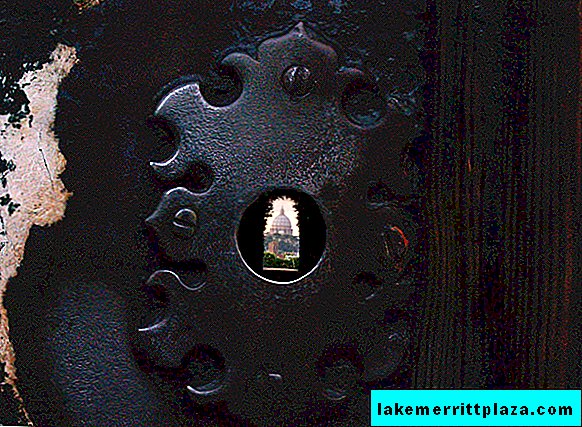The Orange Garden (Giardino degli Aranci) is one of the romantic corners in Rome, a wonderful attraction, which you can visit without prior appointments and expensive tickets.
Picturesque alleys adorn the Aventino hill, from the top of which a wonderful view of the Italian capital opens. City guests and locals adore the garden, for comfort and coolness, as well as the opportunity to look at two states at the same time: the Vatican (Vaticano) and Italy. And just a 500-meter walk is another mini-country - the Order of Malta (Sovrano Militare Ordine Ospedaliero di San Giovanni di Gerusalemme di Rodi e di Malta) with a unique door, looking into the keyhole of which, you will immediately see 3 countries.
- Tip: We recommend to visit the orange garden during a tour of Rome at dawn.
Story

The orange garden occupies about 7800 m2which in the 13th century served to protect Rome.
In 1287, the construction of the Savello family castle was completed on Aventin Hill. Actively used during civil wars, the fortress fell into disrepair by the 18th century. And in 1932, the architect Raffaele De Vico, on the instructions of the municipality, took up the construction of a city park.
For this purpose, the remains of the castle were abolished, and the community of Dominican monks gave away part of their land for public use. Thus, a new observation deck has appeared on the top of Aventina, allowing you to enjoy the panorama, similar to those that adorn the hills of Gianicolo and Pincio.
The observation deck of Yanikula is named after the Italian revolutionary Giuseppe Garibaldi - Piazza Garibaldi. And Pincho is famous for having the famous city park and museum of Rome - the villa and the Borghese gallery on its territory.
Architecture

Aventin encircled the small terraces to give vacationers the opportunity to enjoy the views of the Tiber and the architecture of Rome.
The garden is decorated with orange trees, which provide shade even in the midst of summer. But to enjoy citrus fruits does not work, bitter small fruits are not intended for food. It is noteworthy that orange trees were planted in honor of St. Domenic (lat. Sanctus Dominicus), who founded the monastery at the Church of St. Sabina (Basilica di Santa Sabina).
In terms of architecture, the garden has a clear symmetrical structure. The center of the park is an alley named after Nino Manfredi, an Italian actor and writer. On both sides of the alley are two parts of the square. On one of them, the fountain of the work of Giacomo della Porta, which was moved to the Piazza San Simeone in 1973, was previously flaunted. The square is named after the actor Fiorenzo Fiorentini, who for many years was the artistic director of the summer open-air theater productions in the garden.

The entrance to the Orange Garden or Parco Savello Park is decorated with an ancient fountain similar to the mouth of Truth located at the foot of a hill. Initially, the fountain was a simple Roman thermal bath, lined with travertine. In the 16th century, it was decorated with a carved stone mask, dramatically frowning its lush eyebrows.
Today, the Orange Garden has three entrances: from the side of Piazza Pietro d'Illiria, from Santa di Sabina street, from Clivo di Rocca Savella alley.
Attractions nearby

Church of Santa Sabina
Savello Park is located right next to the church of Santa Sabina (Santa Sabina all'Aventino). Many weddings usually take place in this basilica. In winter, during the flowering of orange trees, couples love to be photographed against the background of trees solemnly cleaned with hats of fleur-de-orange. The snow-white orange petals are a long-standing symbol of the purity of the bride. The best scenery for a wedding photo shoot is simply not to be found!
Maltese Knights Square
And if you go along the Via di Santa Sabina to the southwest, you can get to the Square of the Maltese Knights (Piazza dei Cavalieri di Malta), designed by Giovan Battista Piranesi in 1765. By the way, anyone can legally indulge in peeping into a keyhole installed at the entrance to Villa dei Cavalieri. Through the "forbidden" attraction you can see the dome of St. Peter's Basilica (Basilica di San Pietro) in all its glory!

Rose garden
If, after leaving the Orange Garden, turn left via Via di Santa Sabina, you can quickly get to the luxurious rosary Roseto di Roma Capitale. More than a thousand varieties of roses are beautifully dotted with 10 thousand m2 metropolitan lands.
How to get there

- Address: Via di Santa Sabina
- Bus: No. 81, 85, 87, 160, 628 (to the Greca stop), No. 23, 280, N10 (to the Lungotevere Aventino stop).
- Working hours: from dawn to dusk.
- Site: www.sovraintendenzaroma.it








